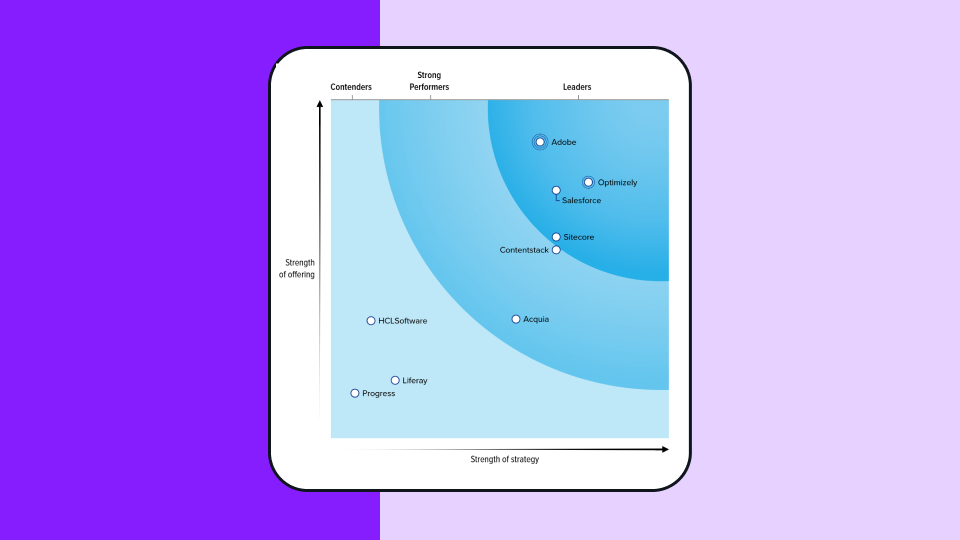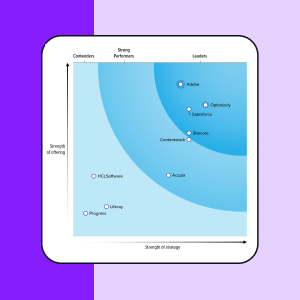Content-Hub
Ein Content-Hub ist eine kuratierte Sammlung von Markeninhalten zu einem bestimmten Thema oder Gegenstand. Sie enthält Artikel, Videos, Infografiken und andere Formen von Inhalten, die den Nutzern einen tiefen Einblick in ein bestimmtes Gebiet geben, in dem die Marke eine Autorität oder ein Experte ist.
Content-Hubs sind es nicht:
- Ein Mittel, um Ihre Produkte oder Dienstleistungen zu verkaufen
- Teil Ihres Sales-Funnels
Wenn sie jedoch richtig eingesetzt werden, sind sie ein wirksames Mittel, um die Autorität Ihrer Marke zu stärken, ihre Präsenz zu erhöhen und Ihren Gesamtumsatz oder Ihre Conversion Rate zu steigern.
So sieht ein Content-Hub online aus
Ein Content-Hub ist in der Regel kleiner als eine Website, aber größer als ein Blog. Content-Hubs sind außerdem themenspezifisch und stark kuratiert. Vermarkter werden in der Regel nicht alle Inhalte finden, die eine Marke jemals produziert hat.
Betrachten Sie unser Optimizely-Glossar im Vergleich zu unserem Blog. Ersteres ist eine spezifische, kuratierte Sammlung von Inhalten rund um Optimierungskonzepte. Im Blog finden Sie alles von Einblicken bis hin zu Unternehmensnachrichten.
Content-Hubs können viele Formen annehmen und eine breite Palette von Medien umfassen. Sie können sie als:
- Hilfezentren oder Wissensdatenbanken
- Archive
- Digitale Zeitschriften
- Streaming-Kanäle
- Blogs (gelegentlich)
Wenn Sie sich auf einer Website zu einem bestimmten Thema schon einmal in einem Kaninchenbau verirrt haben, sind Sie auf einen Content-Hub gestoßen. Einige Beispiele für Content-Hubs im Internet sind:
- Die verschiedenen Publikationenvon Medium
- Red Bulls Red Bulletin
- Bessere Geldgewohnheiten von Bank of America
- Airbnb's Leitfaden für Standorte
Die Anatomie eines Content-Hubs
Genauso wie Content-Hubs verschiedene Formen annehmen können, sind sie auch unterschiedlich aufgebaut. Content-Hubs, bei denen die neuesten Artikel auf der ersten Seite erscheinen, sind selten - anders als bei News-Sites oder Blogs.
Der Grund dafür ist, dass ein Content-Hub Ihren Lesern die Möglichkeit geben soll, ein Thema vollständig zu erkunden. Daher wird die häufigste Struktur eines Content-Hubs als "Nabe und Speiche" bezeichnet - wie bei einem Rad.
Mit der Nabe und der Speiche identifizieren Sie mehrere Themen und dann Unterthemen, die zu diesen Themen gehören. Wenn Ihr Hauptthema zum Beispiel Schuhe ist, dann könnten die Speichen innerhalb der Kategorie "Schuhe" folgende Themen umfassen:
- Sportliche Schuhe
- Arbeitsschuhe
- Kleiderschuhe
- Freizeitschuhe
Jede Unterkategorie, oder Speiche, könnte weitere Unterspeichen haben. Unter Kleiderschuhe könnten Sie Themen wie Absätze oder Lederschuhe finden. (Diese wiederum können zu aktuelleren Artikeln oder dem Beginn Ihres Sales-Funnels führen. Der Zweck eines Content-Hubs ist es jedoch nicht, zu verkaufen, sondern zu informieren.)
Auf Ihrer Hauptseite präsentieren Sie Ihre Hubs mit immergrünen Inhalten, die einen Überblick über das Thema geben. Innerhalb dieser Inhalte verlinken Sie auf spezifischere Unterthemen. Die gesamte Struktur Ihres Content-Hubs ist durchsuchbar, so dass die Besucher zum gewünschten Unterthema springen können, aber Sie versuchen, ein Kaninchenloch zu bauen, das die Leser auf Ihrer Site hält.
Die Vorteile eines Content-Hubs
Richtig gemacht, ist ein Content-Hub eine der besten Möglichkeiten, Ihre Marke online zu etablieren. Er kann:
- Die Sichtbarkeit Ihrer Marke im Internet erhöhen. Ihre Inhalte generieren organischen Traffic, wenn sie in den Suchergebnissen auftauchen.
- Das Markenengagement verbessern. Die Nutzer haben mehr Möglichkeiten, mit Ihrer Marke zu interagieren und eine positive Bindung aufzubauen.
- Generieren Sie mehr Leads oder Verkäufe. Content-Hubs erfordern eine Content-Strategie und Marketing, um zu funktionieren. Dieser Ansatz für Inhalte kann dreimal mehr Leads generieren als andere Formen des digitalen Marketings. Der Einsatz einer E-Commerce-Plattform kann auch dazu beitragen, den Umsatz direkt zu steigern.
- Heben Sie sich von Ihren Mitbewerbern ab. Es wird immer schwieriger, sich online zu differenzieren, aber Inhalte sind nach wie vor ein bewährtes Mittel, um dies zu tun. Außerdem können Sie damit Ihr Fachwissen besser demonstrieren und so beweisen, dass Ihre Produkte oder Dienstleistungen vertrauenswürdig sind.
Wie man einen Content-Hub aufbaut
Ein Content-Hub ist eine großartige Ergänzung Ihrer Webpräsenz, wenn es ein Thema gibt, in dem Sie wirklich ein Experte sind. Hier sind die Schritte, die Sie unternehmen müssen, um einen solchen Hub zu erstellen.
-
Entwickeln Sie eine Content-Strategie
Eine Content-Strategie bringt Ihre Unternehmens- und Markenziele mit Ihren Inhalten in Einklang. Sie zielt darauf ab, Probleme, die Ihr Unternehmen oder Ihre Kunden haben, mit Inhalten zu lösen.
Sie ist auch das Rückgrat Ihres Content-Hubs.
Ihre Content-Strategie sollte:
- Identifizieren Sie die Knotenpunkte Ihres Content-Hubs. Sie müssen sich noch keine Gedanken über einzelne Artikel machen, aber Sie sollten ein solides Verständnis dafür haben, warum Sie schreiben, was Sie schreiben.
- Legen Sie einen Zeitplan fest. Darin sollten Sie festlegen, was Sie wann veröffentlichen, und einen Plan für die Pflege bereits vorhandener Inhalte aufstellen.
- Wie Sie Ihre Inhalte verbreiten werden. Werden Sie sich auf SEO verlassen? Werden Sie neue Inhalte in einer wöchentlichen Zusammenfassung an Ihre Mailingliste schicken? Je nach Ihren Zielen gibt es keinen richtigen oder falschen Weg, dies zu tun.
-
Wählen Sie ein geeignetes CMS und DAM
Sie benötigen ein leistungsstarkes Content Management System, um Ihren Hub zu organisieren. Es gibt sowohl kostenlose als auch proprietäre Optionen. (Hier erfahren Sie mehr über sie.)
Wenn Sie schon dabei sind, sollten Sie auch überlegen, ob ein Digital Asset Management (DAM) das Richtige für Sie ist. Die Verwaltung von Inhalten ist in der Regel in diese Systeme integriert, und sie erleichtern es dem Team, den Überblick über kreative Inhalte wie Bilder, Videos und Dokumente zu behalten.
-
Inhalte erstellen und veröffentlichen
Jetzt ist es an der Zeit, die Inhalte zu erstellen! Sie können dies selbst tun, oder Sie können die Erstellung auslagern. Etwa 80 Prozent der Unternehmen tun dies.
Pro-Tipp: Sie werden versucht sein, mit diesem Schritt zu beginnen, aber lassen Sie es. Wenn Sie zuerst die oben genannten Schritte ausführen, können Sie sich in der Erstellungsphase besser konzentrieren und die Arbeit straffen.
-
Steigern Sie Ihre Sichtbarkeit mit Verbreitungsstrategien
Die Content-Strategie bezieht sich auf die Planung Ihrer Inhalte, während Content Marketing die eigentliche Erstellung, Veröffentlichung und Verbreitung Ihrer Inhalte umfasst.
Einige Beispiele für Strategien zur Verbreitung von Inhalten sind:
- Suchmaschinenoptimierung (SEO)
- Trichter für soziale Medien
- Newsletter oder andere Direktwerbung für Fans
-
Verfolgen Sie die Leistung Ihres Hubs
Inhalte sind keine Sache, die man einfach mal so macht. Wenn Sie verfolgen, wie oft Ihre Inhalte aufgerufen werden, wie viele Personen sich mit ihnen beschäftigen und welche Inhalte zu Conversions führen, können Sie feststellen, welche Inhalte gut funktionieren und welche Hilfe benötigen. Die Nachverfolgung von Metriken ist ein wichtiger Bestandteil jedes guten Content-Workflows.
Eine DXP-Plattform kann Ihnen dabei helfen, ebenso wie kostenlose Tools wie Google Analytics.
Achten Sie auch darauf, wie Ihre Konkurrenten reagieren, wenn Ihr Content-Hub expandiert. Bauen sie als Reaktion darauf ihre eigene Plattform auf? Das bedeutet, dass Sie einen Volltreffer gelandet haben und sich nun darauf konzentrieren können, noch mehr hochwertige Inhalte zu produzieren.

